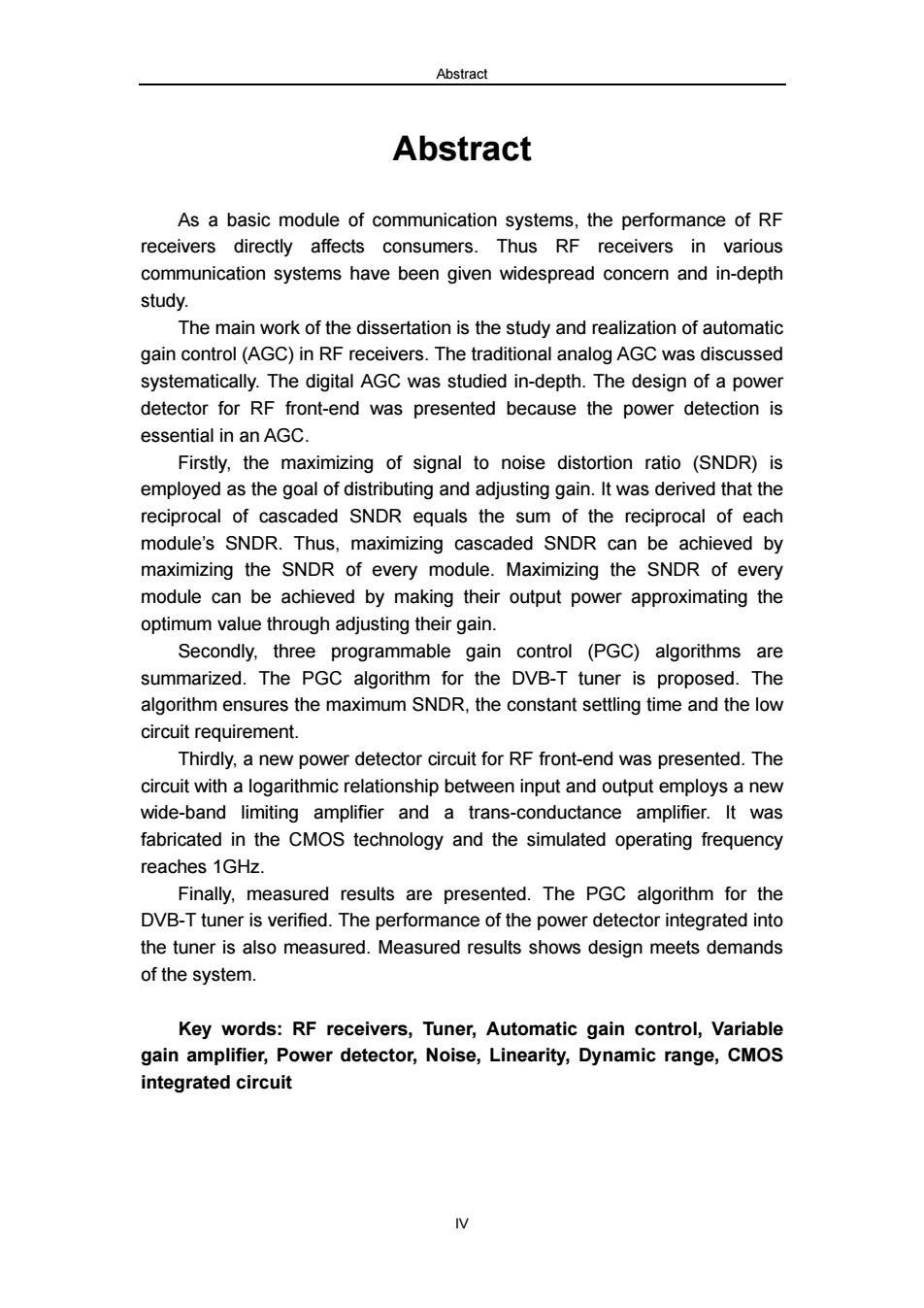正在加载图片...

Abstract Abstract As a basic module of communication systems,the performance of RF receivers directly affects consumers.Thus RF receivers in various communication systems have been given widespread concern and in-depth study. The main work of the dissertation is the study and realization of automatic gain control(AGC)in RF receivers.The traditional analog AGC was discussed systematically.The digital AGC was studied in-depth.The design of a power detector for RF front-end was presented because the power detection is essential in an AGC. Firstly,the maximizing of signal to noise distortion ratio (SNDR)is employed as the goal of distributing and adjusting gain.It was derived that the reciprocal of cascaded SNDR equals the sum of the reciprocal of each module's SNDR.Thus,maximizing cascaded SNDR can be achieved by maximizing the SNDR of every module.Maximizing the SNDR of every module can be achieved by making their output power approximating the optimum value through adjusting their gain. Secondly,three programmable gain control (PGC)algorithms are summarized.The PGC algorithm for the DVB-T tuner is proposed.The algorithm ensures the maximum SNDR,the constant settling time and the low circuit requirement. Thirdly,a new power detector circuit for RF front-end was presented.The circuit with a logarithmic relationship between input and output employs a new wide-band limiting amplifier and a trans-conductance amplifier.It was fabricated in the CMOS technology and the simulated operating frequency reaches 1GHz. Finally,measured results are presented.The PGC algorithm for the DVB-T tuner is verified.The performance of the power detector integrated into the tuner is also measured.Measured results shows design meets demands of the system. Key words:RF receivers,Tuner,Automatic gain control,Variable gain amplifier,Power detector,Noise,Linearity,Dynamic range,CMOS integrated circuit NAbstract IV Abstract As a basic module of communication systems, the performance of RF receivers directly affects consumers. Thus RF receivers in various communication systems have been given widespread concern and in-depth study. The main work of the dissertation is the study and realization of automatic gain control (AGC) in RF receivers. The traditional analog AGC was discussed systematically. The digital AGC was studied in-depth. The design of a power detector for RF front-end was presented because the power detection is essential in an AGC. Firstly, the maximizing of signal to noise distortion ratio (SNDR) is employed as the goal of distributing and adjusting gain. It was derived that the reciprocal of cascaded SNDR equals the sum of the reciprocal of each module’s SNDR. Thus, maximizing cascaded SNDR can be achieved by maximizing the SNDR of every module. Maximizing the SNDR of every module can be achieved by making their output power approximating the optimum value through adjusting their gain. Secondly, three programmable gain control (PGC) algorithms are summarized. The PGC algorithm for the DVB-T tuner is proposed. The algorithm ensures the maximum SNDR, the constant settling time and the low circuit requirement. Thirdly, a new power detector circuit for RF front-end was presented. The circuit with a logarithmic relationship between input and output employs a new wide-band limiting amplifier and a trans-conductance amplifier. It was fabricated in the CMOS technology and the simulated operating frequency reaches 1GHz. Finally, measured results are presented. The PGC algorithm for the DVB-T tuner is verified. The performance of the power detector integrated into the tuner is also measured. Measured results shows design meets demands of the system. Key words: RF receivers, Tuner, Automatic gain control, Variable gain amplifier, Power detector, Noise, Linearity, Dynamic range, CMOS integrated circuit